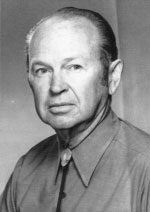Home Page
A Gift Without Strings
 Omar Heins was a man typical of his generation. Frugal. Conservative. Industrious. What wasn't typical about Omar was the bequest he made to UNM Athletics Department—more than $1 million, unrestricted.
Omar Heins was a man typical of his generation. Frugal. Conservative. Industrious. What wasn't typical about Omar was the bequest he made to UNM Athletics Department—more than $1 million, unrestricted.
"It's very unusual to receive this kind of gift," says Larry Ryan, vice president of university development. "It helps athletics programs across the board, which is how Omar wanted it to be."
Omar, a longtime Lobo Club member and a season ticket holder, was an avid fan of athletics. But he also enjoyed just helping others in need, perhaps because of his hardscrabble childhood.
On the Move in America
Omar was born in 1911 in the small town of Corder, Missouri, the sixth of eight children in a German immigrant family. His father owned and operated a creamery and a poultry and egg business. In 1921, 10-year-old Omar's life abruptly changed when his mother died. A couple of years later, his father took a new wife—a woman from fast-paced Kansas City. She convinced him to sell his business and buy a farm in New Jersey, close to Atlantic City.
Omar and his sister Ramona traveled from Missouri to their new home in the back of a Model T Ford delivery truck. They spent the summer on the farm cultivating vegetables and selling the blueberries they picked in the nearby woods.
But Omar and Ramona—along with the other Heins children never developed a close relationship with their stepmother, and Omar didn't relish the prospect of living in New Jersey. So he and Ramona went to Nebraska to live with their oldest sister and her husband. Omar attended high school there while juggling several jobs: shoe and harness repair and painting houses, barns, and anything else that needed a couple of coats of paint.
When he was 19, Omar moved to California to work in his uncles' orange groves. There he saw his first Bowl football game: the 1931 Rose Bowl, Alabama vs. Washington State. This may well have been the beginning of Omar's love of athletics. But many years stood between college-aged Omar and the man who would make the largest individual, unrestricted gift to UNM Athletics in the department's history.
Career, Duty, and Albuquerque
In 1932 Omar went to college in Lincoln, Nebraska, and earned a degree in electrical engineering. After graduation, he worked in Hastings, Nebraska, and Knoxville, Tennessee, before landing a job with the U.S. Department of Agriculture in Albuquerque. But after living in the Duke City a mere six months, the ROTC training he had while at the University of Nebraska pulled him into World War II. Omar reported to Fort Knox, Kentucky, and joined the First Armored Division.
During the next three years, he trained in New York and California before receiving orders to join the 778th Tank Battalion as a staff officer at Camp Howze, Texas. The battalion joined Gen. George S. Patton's Third Army in Metz, France. During the battalion's trek into Germany, it took 109,000 German prisoners—most of whom were eager to escape the Russians.
Gen. Patton promoted Omar to major on January 1, 1945. In December of the same year, Omar returned home. He reported to his old job at the Department of Agriculture, then a year later took an engineering position with the Atomic Energy Commission at Sandia Base. In 1951 his outfit was renamed Sandia National Laboratories. Omar worked there until his retirement in 1974.
Omar "wasn't a hugger," according to his friend and former stockbroker, Charles "Andy" Anderson, but he was a friendly, warm person who married three times. Little is known about his first wife, whom he divorced after returning to the United States after the war. His second wife Mildred (Midge) passed away in 1980 of cancer. Two years after her death, Omar met a woman named Mary while golfing. They hit it off immediately and were married that same year.
Omar and Mary spent the next 17 years traveling all over the world together. When not traveling, they spent winters in Hemet, California, and summers in Albuquerque. Mary's health began deteriorating in 1995, and she passed away in 1997. After her death, Omar wrote a concise autobiography that concluded with the words, "Almost all of my old acquaintances have either moved or passed on. It's mostly a lonely world now for me." Omar died on January 17, 2008, at the age of 96.
The Millionaire Next Door
According to Anderson, Omar made millions in the stock market but was very frugal with it. About the only time he spent money on himself was when he was traveling with Mary. "He lived in a house he built himself," Anderson says. "He was an excellent craftsman; he did it all. He was a fine old gentleman."
Larry Ryan admits he was a bit surprised to learn of Omar's bequest. Omar had established an endowment for athletic scholarships many years ago, but he was not a high-profile Lobo Club member. "Nobody here knew him," Ryan says. "It's a mystery, but what a great gesture. His gift helps our budget significantly."
Omar's gift was made through UNM Lobo Legacy Program, which honors individuals who support UNM athletics through planned gifts. The generosity of Omar and donors like him help the athletic department provide more student scholarships and strengthen its athletic programming.
© Pentera, Inc. Planned giving content. All rights reserved.
Disclaimer
